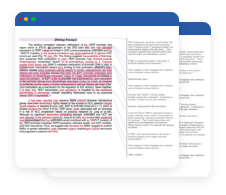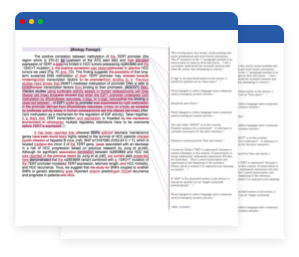대명사의 종류 및 예시
대명사는 명사를 대신하는 품사로써 문장 내에서 주어, 직접 목적어, 간접 목적어, 전치사의 목적어 또는 다른 품사로 사용될 수 있습니다. 사람, 장소, 동물 또는 사물 등을 지칭하기 위해서 사용할 수 있으며, 대명사에는 인칭 대명사, 관계 대명사, 지시 대명사, 재귀 대명사, 부정 대명사, 의문 대명사 그리고 소유 대명사와 같이 여러 가지 종류가 있습니다.
대명사의 종류
| 종류 | 기능 | 예시 |
|---|---|---|
| 인칭 대명사 |
사람, 장소, 사물 또는 생각을 지칭 |
I, me, she, we, us, them, it, you, they |
| 관계 대명사 |
부가적인 정보를 제공하기 위해 문장 내 다른 명사를 지칭 |
Who, whom, whose, which, that, when, where |
| 지시 대명사 |
문장 내에서 이미 등장한 다른 명사를 지칭 |
This, that, these, those, such, none, neither |
| 부정 대명사 |
특정되지 않은 막연한 대상을 지칭 |
Anybody, everybody, nobody, somebody, anyone, everyone, no one, someone, anything, everything, nothing, something |
| 재귀 대명사 |
문장 내 주어와 목적어가 일치할 시, 목적어 자리에서 주어를 다시 지칭 |
Myself, yourself, yourselves, ourselves, himself, herself, itself, themselves |
| 의문 대명사 |
의문의 뜻을 나타냄 |
Who, what, which, whose |
| 소유 대명사 |
소유 또는 명사의 소유를 나타냄 |
My, our, your, his, her, its, their |
인칭 대명사
인칭 대명사는 대표적인 대명사로 사람과 사물을 가리키는 대명사입니다. 1인칭(I), 2인칭(you), 3인칭(he, she, it, they). 와 같은 단어를 가리킵니다. 인칭 대명사는 성(남성, 여성), 수(단수, 복수) 그리고 대신하는 명사의 격(주격, 목적격, 소유격)에 따라 다른 형태를 지닙니다. I, you, he, she, it, we they, me, him, her, us, and them은 모두 인칭 대명사입니다.
- 예시
- She is clever.
- 예시
- Did you make a reservation for three?
- 예시
- I hope you will invite them to the party.
선행 명사
사를 사용할 때에는 선행 명사를 사용하여 대명사가 무엇을 지칭하는지 명확하게 나타내야 합니다. 선행 명사란 문장 내에서 대명사가 사용되기 이전에 먼저 등장하는 명사 또는 명사구로 이후에 대명사로 대체할 수 있습니다.
- 예시
- Sam drank most of the juice that he bought.
- 예시
- The team has tried its best to achieve success.
- 예시
- Many people lost their jobs because of the economic slowdown.
불명확 또는 모호한 대명사 사용
- 예시
- If you arrive late to the play, she won't let you in.
- 예시
- Sam sent a letter to Mark addressing the problems he encountered during his first year at school.
관계 대명사
관계 대명사는 관계사절 또는 독립절을 연결하고 문장 내에 등장하는 사람 또는 사물에 대해 부가적인 정보를 제공하기 위해 사용합니다. 관계 대명사는 수식하는 명사 또는 대명사 바로 다음에 사용하며, 흔히 사용하는 관계 대명사에는 Who, whom, whose, which, that, when, and where가 있습니다.
- 예시
- Is the man who came to look for you your father?
- 예시
- She likes books that tell stories of famous people.
- 예시
- That store, where we usually buy our groceries, is closed for the holidays.
Who vs. whom: 주어 및 목적어 대명사
Who와 whom을 언제 사용할지 헷갈리는 경우가 많습니다. Who와 whom 모두 대명사로 사용할 수 있으나, 용도는 다릅니다. Who는 문장의 주어를 지칭하기 위해 사용하는 반면 who는 동사 또는 전치사의 목적어를 지칭하기 위해 사용합니다.
- 틀린 문장
- Whom should be elected as the leader?
- 올바른 문장
- Who should be elected as the leader?
- 틀린 문장
- He is the person to who I am married.
- 올바른 문장
- He is the person to whom I am married.
- 틀린 문장
- You didn’t specify the officer who I should give this form to.
- 올바른 문장
- You didn’t specify the officer to whom I should give this form.
지칭 대명사
지칭 대명사는 문장 내에 등장하는 특정한 사람 또는 사물을 지칭하기 위해 사용합니다. 지칭 대명사는 시간 또는 공간의 정도를 나타낼 수 있습니다. 흔히 사용하는 지칭 대명사에는 This, that, these, those, such, none, and neither가 있습니다.
- 예시
- He is late again. That boy is really getting on my nerves.
- 예시
- She loves all kinds of sports. These include badminton and soccer.
- 예시
- I don't like math or science. Neither is fun.
부정 대명사
부정 대명사는 특정한 사람이나 사물을 가리키지 않고 막연한 대상을 가리킬 때 사용합니다. 부정관사와 마찬가지로 부정 대명사는 특정되지 않은 대상을 가리킵니다. 흔히 사용하는 부정 대명사에는 Anybody, everybody, nobody, somebody, anyone, everyone, no one, someone, anything, everything, nothing, and something이 있습니다.
- 예시
- No one likes to have to beg for something.
- 예시
- Everyone is welcome to join the class.
- 예시
- Anything is possible only if you keep trying.
재귀 대명사
재귀 대명사는 문장 내에서 주어와 목적어가 일치하며 다시 주어를 지칭할 경우에 목적어 자리에 재귀 대명사를 사용합니다. 재귀 대명사는 단수일 경우에는 "-self"로 끝나며, 복수일 경우에는 "-selves"로 끝납니다. 흔히 사용하는 재귀 대명사에는 Myself, yourself, yourselves, ourselves, himself, herself, itself, and themselves가 있습니다.
- 예시
- I saw myself in the mirror.
- 예시
- The book itself isn't difficult, but it's not fun to read.
- 예시
- They recommend this movie even though they have never seen it themselves.
의문 대명사
의문 대명사는 의문사이면서 대명사의 역할을 합니다. 흔히 사용하는 의문 대명사에는 Who, what, which, whose가 있습니다.
- 예시
- Which essay did you like the best?
- 예시
- Whose bag is this?
소유 대명사
소유 대명사는 소유를 나타내거나 어떤 사물 또는 어떤 사람이 다른 사물 또는 다른 사람에게 소속되어 있거나 관계가 있다는 사실을 나타내기 위해 사용합니다. 흔히 사용하는 소유 대명사에는 My, our, your, his, her, its, their가 있습니다. 소유 대명사를 사용하여 문장 내에서 같은 단어 또는 어구를 반복적으로 사용하는 것을 피할 수 있으며 따라서 문장을 더욱 더 간결하게 만들 수 있습니다.
- 예시
-
I don't know where my sneakers went, so my sister lent me her sneakers.
I don't know where my sneakers went, so my sister lent me hers.
- 예시
-
Your plan sounds just as exciting as my plan.
Your plan sounds just as exciting as mine.
대명사 사용의 정확성을 높이기 위해, 문장을 작성한 후 문법 검사기를 활용하여 문법적 오류를 점검하는 것이 좋습니다. 이러한 도구를 사용하면 대명사와 그 지시 대상 간의 일관성을 유지하고, 모호한 표현을 방지하는 데 도움이 됩니다.



